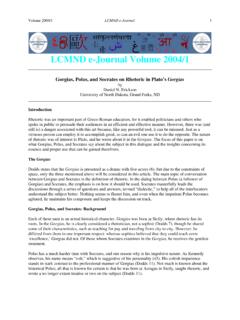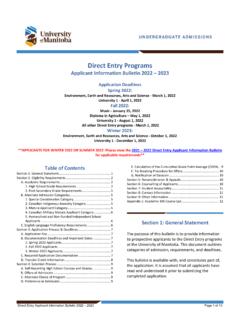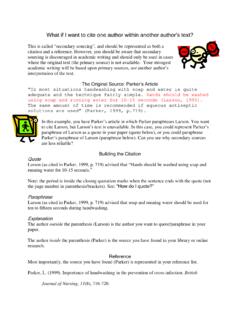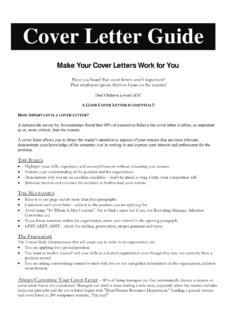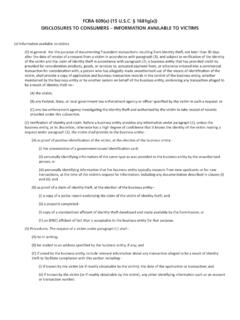Transcription of A Guide to INVESTIGATING WORKPLACE INCIDENTS
1 WORKPLACE SAFETY AND HEALTH COMMITTEE A Guide to INVESTIGATING WORKPLACE INCIDENTS MAY 2003 2 Section 1 - DEFINITIONS WHAT IS AN INCIDENT? An incident is any unplanned event that causes injury. A dangerous occurrence is any event that could have caused injury, but did not. The term incident will be used to describe both INCIDENTS and dangerous occurrences. WHAT IS AN INCIDENT INVESTIGATION? An incident investigation is the account and analysis of an incident based on information gathered by a thorough examination of all contributing factors and causes involved. reporting SERIOUS INCIDENTS When a serious incident occurs at a WORKPLACE , the employer is required to notify Manitoba Labour and Immigration WORKPLACE Safety and Health Division. Under Manitoba Regulation 108/88R, Section 8, such notification must take place immediately after a serious incident, using the fastest means of communication available.
2 A Safety and Health Officer is on duty 24 hours each day of the week to respond to emergency calls. The question often asked of the WORKPLACE Safety and Health Division is: How do you define a serious incident? WORKPLACE Safety and Health Division considers an incident to be serious if it results in: death, or serious injury (as defined below), collapse or structural failure of a building, tower, crane, hoist, temporary construction support system or excavation, an uncontrolled spill or escape of a toxic, corrosive or explosive substance explosion, fire or flooding. Serious injuries are defined as: fracture of a major bone amputation loss of sight internal hemorrhage third degree burns unconsciousness resulting from concussion, electrical contact, asphyxiation poisoning cuts requiring hospitalization or time off work any injury resulting in paralysis any other injury likely to endanger life or cause permanent disability.
3 The Regulation also stipulates that equipment or materials involved in a serious incident shall not be moved, unless it is necessary to release an injured person or to avoid creating additional hazards. 3 Section 2 INVESTIGATION CONCEPTS WHY DO WE INVESTIGATE INCIDENTS ? Prevention is the purpose of an investigation. An incident investigation should: determine what actually happened, determine the cause or causes of the incident, identify any unsafe conditions, acts or procedures, help management to identify practical corrective actions, determines whether due diligence was observed, show the commitment of management that an adequate investigation system is in place. The purpose of these activities is not to find fault or lay blame, but rather to identify the basic causes of INCIDENTS so that controls can be put in place to prevent further occurrences. Information from the investigation should be put on the record, but not used to discipline anyone.
4 This policy encourages witnesses to tell investigators everything they know. What is Due Diligence? As a result of the 1978 court case of R. vs. Sault Ste. Marie, due diligence can be defined as: ..whether the accused exercised all reasonable care by establishing a proper system to prevent commission of the offence and by taking reasonable steps to ensure the effective operation of the system. Simply put, due diligence means taking all reasonable care in the circumstances to protect the safety and health of all workers. It must be expressed in behaviour and attitudes in the WORKPLACE , it can not be made up after the fact. The employer must be able to demonstrate their due diligence in an objective manner. A defense cannot succeed if the employer states that they intended to provide a safe and healthy WORKPLACE . The employer must give actual proof of real attempts to do so. The measures that will be necessary to prove due diligence in court will depend on the particular circumstances of each case.
5 UNDERLYING PRINCIPLES INCIDENTS don t just happened. They are caused. INCIDENTS can be prevented if causes are eliminated Causes can be eliminated if all INCIDENTS are investigated properly. Unless the causes are eliminated, the same situation will reoccur. Develop a procedure to investigate INCIDENTS Section (5)(I) of the WORKPLACE Safety and Health Act procedure for the investigation of INCIDENTS , dangerous occurrences and refusals to work pursuant to Section 43 of the Act. Investigation of INCIDENTS provide valuable information needed to prevent similar INCIDENTS in the future. There are many good reasons why supervisors and managers should investigate INCIDENTS and near misses. One of the most important reasons is that supervisors and managers are responsible for making sure any problems are corrected. In addition, Section 40(10)(I) of the Act requires the WORKPLACE safety and health committee to participate in investigations of INCIDENTS .
6 4 What should be included in incident investigation procedures? Investigation procedures for INCIDENTS must fit your needs. Ideally, they should state: the objective of your investigations (find and correct root causes) who investigates what INCIDENTS what training investigators and incident responders will receive who receives the written investigation reports who must fix defects found during an investigation who follows-up on corrective action what investigation reports and follow-up records will be kept who keeps what documents and records what summary and statistics reports are to be developed and how often these reports will be prepared. THE SUPERVISOR S ROLE The supervisor of the area where the incident takes place should be extensively involved in conducting the investigation. Since supervisors are responsible for worker training and activities on-the-job, they know the work assignments and have issued the work instructions.
7 The supervisor will be responsible for ensuring that appropriate preventative measures are taken and that those actions are effective in reducing or eliminating the possibility of recurrence. SAFETY AND HEALTH COMMITTEE/REPRESENTATIVE Manitoba s WORKPLACE Safety and Health Act describes the duties of the safety and health committee under Section 40(10). One of the primary duties of a committee is noted under 40(10)(i) to participate in investigation of INCIDENTS and dangerous occurrences. An effective committee/representative should have a good working knowledge of the work site, the equipment, hazards present and the people involved. Members will know the questions to ask and the information to consider as well as who to contact for technical advice. Both committee co-chairpersons, or other members of the committee, or the worker representative should be on the investigation team. Involving the committee/representative improves the credibility of the investigation in the eyes of many workers.
8 It also keeps lines of communication open. The recommendations contained in the report are likely to be accepted by workers if their representatives on the safety and health committee participate. EXPERTS Depending on the circumstances, persons with expertise may be called upon to be involved or actually conduct the investigation. The determining factor for involving an expert relates to the severity and complexity of the incident. For example, in the case of a fire, outside experts in fire investigation will be utilized. If the investigator is not familiar with machinery involved in an incident, he or she should consult someone who has experience and skill in a particular situation. 5 WHAT INCIDENTS SHOULD BE INVESTIGATED? INCIDENTS where injuries have occurred or have the potential for injury or loss should be investigated. The degree to which an incident is investigated is dependent on its severity and the potential for it to reoccur.
9 INCIDENTS to investigate: All time-loss injuries should be reviewed by the employer and all information provided to the Safety and Health Committee. In addition, the employer must ensure that the committee is involved in investigations of INCIDENTS involving: a) Death or serious injury (serious INCIDENTS include: fracture of a major bone; amputation; loss of sight; internal hemorrhage; third degree burns; unconsciousness resulting from concussion, electrical contact, asphyxiation; poisoning; cuts requiring hospitalization or time off work; any injury resulting in paralysis; any other injury likely to endanger life or cause permanent diability). b) Collapse or structural failure of building, tower, crane, hoist, temporary construction support system or excavation. c) An uncontrolled spill or escape of a toxic, corrosive or explosive substance d) Explosion, fire or flooding. INTERNAL RESPONSIBILITY The employer and the workers share an equal concern in preventing INCIDENTS and ill-health arising out of conditions in the WORKPLACE .
10 The intent of the safety and health committee/representative is to enhance the ability of workers and employers to resolve safety and health concerns reasonably and co-operatively. They should do so on their own, with a minimum of government involvement. The Safety and Health Officer may conduct an incident investigation to determine if due diligence was practiced. The Safety and Health Officer may require the employer to conduct their own investigation, depending if there is a safety and health committee or representative with the firm. INCIDENT CAUSATION INCIDENTS usually result from unsafe acts and conditions. These unsafe acts and conditions often arise because of defects in the safety and health program. A safety and health program by way of policies and procedures for organizing and performing work defines the safe standards. Without a safety and health program or with a non-functional program, workers and supervisors must devise their own safety and health standards.

